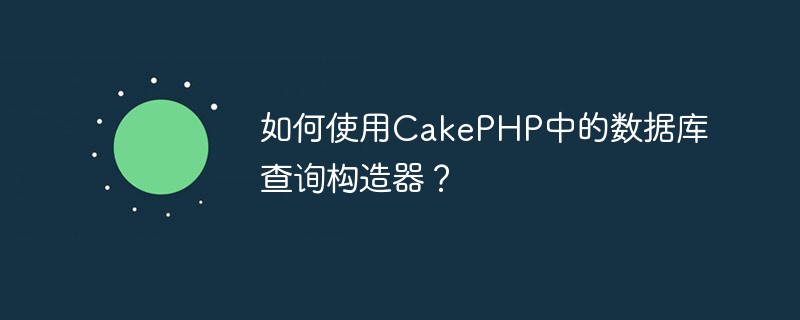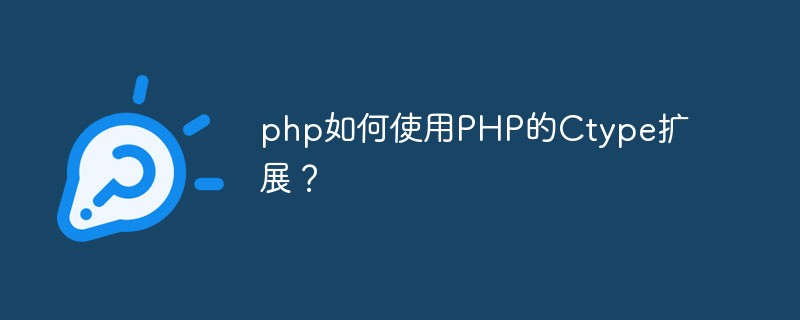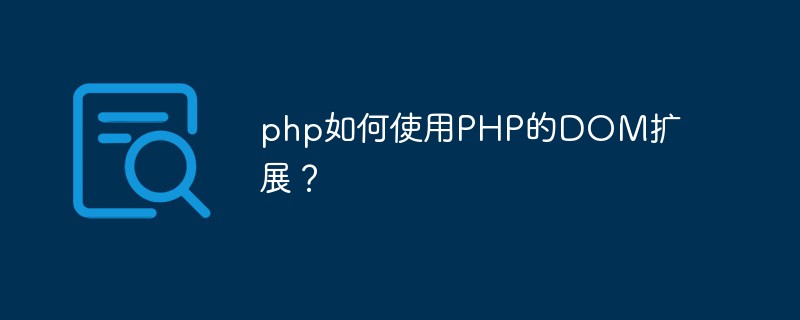How to use PHP's caching technology to improve performance?
With the rapid development of the Internet, website performance has become more and more important for user experience and SEO ranking. As a commonly used server-side scripting language, PHP's performance plays a vital role in the response speed of the website. PHP's caching technology is an important means to improve performance.
1. Why use caching technology?
Before understanding how to use PHP's caching technology, let's first understand why we need to use caching technology. In Web development, the generation of a page usually requires a series of time-consuming operations such as database query and file reading. For those page content that does not change frequently, regenerating it every time it is requested will cause unnecessary waste of resources. Using caching technology, these page contents can be cached to reduce the server's calculation and response time and improve the page access speed.
2. Using PHP’s caching technology
- Page caching
Page caching refers to saving the output results of the entire page in the cache. When there is the same request for the second time, it is obtained directly from the cache without performing database queries and other time-consuming operations. Generally speaking, you can use the ob_start() and ob_end_flush() functions to implement page caching.
Example:
<?php ob_start(); // 页面内容 $content = ob_get_contents(); // 获取页面内容 ob_end_flush(); // 输出页面内容并清空缓存
- Data caching
Data caching is to save some frequently queried and used data in memory. To reduce frequent queries to the database and improve response speed. In PHP, you can use memcached, APCu and other extensions to implement data caching.
Example:
<?php
$memcache = new Memcache;
$memcache->connect('localhost', 11211);
$data = $memcache->get('data'); // 从缓存中获取数据
if(!$data) {
$data = // 从数据库或其他耗时操作中获取数据
$memcache->set('data', $data, false, 3600); // 将数据保存在缓存中,过期时间为3600秒
}
// 使用$data变量进行操作- File caching
File caching is to save some frequently read data in files to reduce the impact on the database and Memory consumption is usually used to store some static content, such as configuration files, template files, etc. In PHP, you can use functions such as file_put_contents() and file_get_contents() to implement file caching.
Example:
<?php
$filename = 'cache.txt';
if(file_exists($filename) && (time() - filemtime($filename) < 3600)) {
$data = file_get_contents($filename); // 从缓存文件中读取数据
} else {
$data = // 从数据库或其他耗时操作中获取数据
file_put_contents($filename, $data); // 将数据保存到缓存文件中
}
// 使用$data变量进行操作3. Precautions for caching technology
- Cache update
When the data in the cache changes , the cache needs to be updated in time to ensure that the data in the cache is consistent with the data in the database. You can use scheduled tasks or event triggers to implement automatic cache updates.
- Cache Invalidation
Cache generally sets an expiration time. Once it expires, it needs to be cached again. When setting the cache expiration time, it needs to be reasonably determined based on business needs to avoid performance problems caused by cache failure.
- Cache penetration
Cache penetration means that the request cannot be cached, resulting in the need to regenerate the result for each request. To avoid cache penetration problems, techniques such as bloom filters can be used.
Summary:
Using PHP's caching technology can greatly improve the performance of the website, reduce the load on the server, and improve the user experience. In actual applications, it is necessary to select a suitable cache strategy based on business needs, and perform reasonable configuration and tuning to achieve the best performance optimization effect. At the same time, you also need to pay attention to cache update and invalidation issues to ensure data consistency and reliability. I hope this article will help you understand and use PHP's caching technology.
The above is the detailed content of PHP performance improvement: utilizing caching technology. For more information, please follow other related articles on the PHP Chinese website!
 php如何使用PHP的Intl扩展?May 31, 2023 pm 08:10 PM
php如何使用PHP的Intl扩展?May 31, 2023 pm 08:10 PMPHP的Intl扩展是一个非常实用的工具,它提供了一系列国际化和本地化的功能。本文将介绍如何使用PHP的Intl扩展。一、安装Intl扩展在开始使用Intl扩展之前,需要安装该扩展。在Windows下,可以在php.ini文件中打开该扩展。在Linux下,可以通过命令行安装:Ubuntu/Debian:sudoapt-getinstallphp7.4-
 如何使用CakePHP中的数据库查询构造器?Jun 04, 2023 am 09:02 AM
如何使用CakePHP中的数据库查询构造器?Jun 04, 2023 am 09:02 AMCakePHP是一个开源的PHPMVC框架,它广泛用于Web应用程序的开发。CakePHP具有许多功能和工具,其中包括一个强大的数据库查询构造器,用于交互性能数据库。该查询构造器允许您使用面向对象的语法执行SQL查询,而不必编写繁琐的SQL语句。本文将介绍如何使用CakePHP中的数据库查询构造器。建立数据库连接在使用数据库查询构造器之前,您首先需要在Ca
 php如何使用CI框架?Jun 01, 2023 am 08:48 AM
php如何使用CI框架?Jun 01, 2023 am 08:48 AM随着网络技术的发展,PHP已经成为了Web开发的重要工具之一。而其中一款流行的PHP框架——CodeIgniter(以下简称CI)也得到了越来越多的关注和使用。今天,我们就来看看如何使用CI框架。一、安装CI框架首先,我们需要下载CI框架并安装。在CI的官网(https://codeigniter.com/)上下载最新版本的CI框架压缩包。下载完成后,解压缩
 php如何使用PHP的Ctype扩展?Jun 03, 2023 pm 10:40 PM
php如何使用PHP的Ctype扩展?Jun 03, 2023 pm 10:40 PMPHP是一种非常受欢迎的编程语言,它允许开发者创建各种各样的应用程序。但是,有时候在编写PHP代码时,我们需要处理和验证字符。这时候PHP的Ctype扩展就可以派上用场了。本文将就如何使用PHP的Ctype扩展展开介绍。什么是Ctype扩展?PHP的Ctype扩展是一个非常有用的工具,它提供了各种函数来验证字符串中的字符类型。这些函数包括isalnum、is
 Vue 中的单文件组件是什么,如何使用?Jun 10, 2023 pm 11:10 PM
Vue 中的单文件组件是什么,如何使用?Jun 10, 2023 pm 11:10 PM作为一种流行的前端框架,Vue能够提供开发者一个便捷高效的开发体验。其中,单文件组件是Vue的一个重要概念,使用它能够帮助开发者快速构建整洁、模块化的应用程序。在本文中,我们将介绍单文件组件是什么,以及如何在Vue中使用它们。一、单文件组件是什么?单文件组件(SingleFileComponent,简称SFC)是Vue中的一个重要概念,它
 php如何使用PHP的geoip扩展?Jun 01, 2023 am 09:13 AM
php如何使用PHP的geoip扩展?Jun 01, 2023 am 09:13 AMPHP是一种流行的服务器端脚本语言,它可以处理网页上的动态内容。PHP的geoip扩展可以让你在PHP中获取有关用户位置的信息。在本文中,我们将介绍如何使用PHP的geoip扩展。什么是PHP的GeoIP扩展?PHP的geoip扩展是一个免费的、开源的扩展,它允许你获取有关IP地址和位置信息的数据。该扩展可以与GeoIP数据库一起使用,这是一个由MaxMin
 php如何使用PHP的DOM扩展?May 31, 2023 pm 06:40 PM
php如何使用PHP的DOM扩展?May 31, 2023 pm 06:40 PMPHP的DOM扩展是一种基于文档对象模型(DOM)的PHP库,可以对XML文档进行创建、修改和查询操作。该扩展可以使PHP语言更加方便地处理XML文件,让开发者可以快速地实现对XML文件的数据分析和处理。本文将介绍如何使用PHP的DOM扩展。安装DOM扩展首先需要确保PHP已经安装了DOM扩展,如果没有安装需要先安装。在Linux系统中,可以使用以下命令来安
 php如何使用CI4框架?Jun 01, 2023 pm 02:40 PM
php如何使用CI4框架?Jun 01, 2023 pm 02:40 PMPHP是一种广泛使用的服务器端脚本语言,而CodeIgniter4(CI4)是一个流行的PHP框架,它提供了一种快速而优秀的方法来构建Web应用程序。在这篇文章中,我们将通过引导您了解如何使用CI4框架,来使您开始使用此框架来开发出众的Web应用程序。1.下载并安装CI4首先,您需要从官方网站(https://codeigniter.com/downloa


Hot AI Tools

Undresser.AI Undress
AI-powered app for creating realistic nude photos

AI Clothes Remover
Online AI tool for removing clothes from photos.

Undress AI Tool
Undress images for free

Clothoff.io
AI clothes remover

AI Hentai Generator
Generate AI Hentai for free.

Hot Article

Hot Tools

SecLists
SecLists is the ultimate security tester's companion. It is a collection of various types of lists that are frequently used during security assessments, all in one place. SecLists helps make security testing more efficient and productive by conveniently providing all the lists a security tester might need. List types include usernames, passwords, URLs, fuzzing payloads, sensitive data patterns, web shells, and more. The tester can simply pull this repository onto a new test machine and he will have access to every type of list he needs.

MinGW - Minimalist GNU for Windows
This project is in the process of being migrated to osdn.net/projects/mingw, you can continue to follow us there. MinGW: A native Windows port of the GNU Compiler Collection (GCC), freely distributable import libraries and header files for building native Windows applications; includes extensions to the MSVC runtime to support C99 functionality. All MinGW software can run on 64-bit Windows platforms.

SublimeText3 Mac version
God-level code editing software (SublimeText3)

SAP NetWeaver Server Adapter for Eclipse
Integrate Eclipse with SAP NetWeaver application server.

Zend Studio 13.0.1
Powerful PHP integrated development environment






